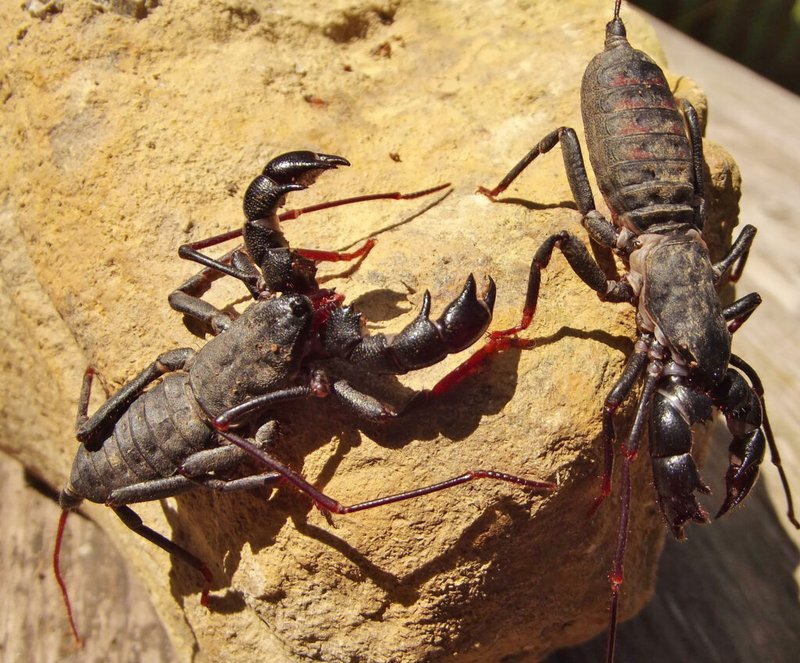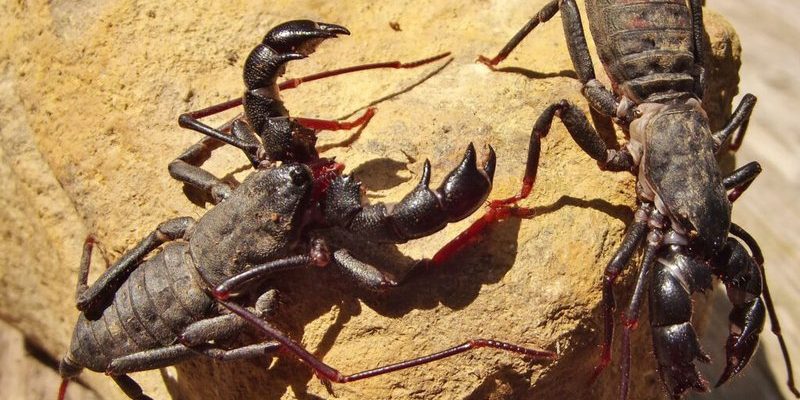
The vinegaroon belongs to a group of arachnids known as Uropygi, which translates to “tail in the rear.” This name makes sense when you see their long, whip-like tail, used for balance and not stinging. In fact, vinegaroons are often confused with scorpions, but they aren’t closely related. Their body style is somewhat similar, yet they lack the venomous sting most people associate with scorpions.
These creatures are typically found in warm, humid environments, making them members of the family that thrives in tropical and subtropical regions. They enjoy hiding in damp places like leaf litter or under rocks during the day, emerging at night to hunt for food. Their diet consists mainly of insects, which they capture with their pincers—think of them as nature’s tiny predators.
Vinegaroons are also remarkable for their unique defense mechanism. When threatened, they can spray a vinegar-like liquid from their abdomen. This not only creates an unpleasant odor but can also irritate the eyes of potential predators. This means that a vinegaroon can both intimidate and deter a larger animal simply through its natural defenses!
Physical Characteristics
When you look at a vinegaroon, one of the first things you’ll notice is its size. They typically range from about 1 to 3 inches in length, with their bodies usually being dark brown or black! Their pincers are quite large compared to their body, giving them quite a fierce appearance. But don’t let that scare you; they aren’t harmful to humans. Imagine a mini dinosaur with its fierce claws—it’s all about the show!
Their long, whip-like tail is also a striking feature. While it might look dangerous, it mainly aids in balance—kind of like how a skateboarder uses their arms to stay balanced when performing tricks. This tail, while flexible, doesn’t have a stinger like a scorpion, so you can breathe easy around these critters!
Another interesting aspect is their eyes. Vinegaroons possess multiple tiny eyes, which help them detect movement around them, crucial for both hunting and evading threats. It’s almost like having a built-in security system, always on alert for any potential dangers.
Habitat and Distribution
Vinegaroons prefer warm, moist habitats. This is why you’ll often find them in tropical rainforests, deserts, and even arid regions with occasional humidity. They’re most commonly spotted in the Southern United States, Mexico, and parts of Central and South America. Their preference for moist environments helps them stay hydrated and provides plenty of food sources like insects.
In terms of living arrangements, vinegaroons like to burrow into the ground or hide under rocks and logs during the day. This behavior protects them from predators and the sun’s harsh rays. Imagine tucking yourself into a cozy blanket on a chilly evening—it’s their version of comfort and safety!
While they aren’t abundant in some regions, their presence in specific habitats is crucial for maintaining the ecological balance. They help control pest populations, acting as natural pest controllers in the ecosystems they inhabit. So, the next time you see one of these fascinating creatures, remember they’re playing an important role in our environment!
Diet and Behavior
Vinegaroons are nocturnal hunters, which means they come alive at night. Their diet primarily consists of insects, making them carnivorous. They have specialized pincers that help them capture and immobilize prey. You can think of them as the night shift workers of the arachnid world, prowling around in search of a late-night snack!
Their hunting technique is quite simple yet effective. Once they spot an insect, they swiftly use their pincers to grab it and then consume it with their specialized mouthparts. The interesting part? Vinegaroons don’t just hunt; they also play a role in the greater ecosystem by helping control insect populations. It’s like nature’s way of keeping everything in balance.
In terms of behavior, vinegaroons are solitary creatures and don’t tend to socialize unless it’s for mating. You might say they enjoy their “me time” and prefer to stay out of the limelight. This behavior makes sense when you think about their camouflage; they blend in with their surroundings to avoid detection by both predators and potential meals.
Reproduction and Life Cycle
Vinegaroons engage in a fascinating courtship ritual that can be quite elaborate. Males often perform a dance-like motion to attract females, waving their pedipalps (the pincers) around with grace, almost like a charming suitor trying to impress. Once a female is receptive, mating occurs, and this can sometimes take several hours!
After mating, females can lay between 20 to 80 eggs, which they carefully guard. These eggs hatch into tiny versions of their parents, called “nymphs,” which resemble miniature vinegaroons. Unlike many insects that go through metamorphosis, these nymphs continue to grow and shed their exoskeletons until they reach adulthood—a process that can take several months to a couple of years depending on environmental conditions.
The life span of vinegaroons can vary, usually living up to three years or more in the wild. Like many creatures, their survival depends heavily on factors like food availability and predator presence. So, while they might be small, they have a significant impact on their ecosystem during their lives!
Vinegaroons in Culture and Myth
Surprisingly, vinegaroons have found a place in various cultural references and myths. In some indigenous cultures, their unique ability to spray vinegar has led to associations with both protection and fear. The spray is often seen as a form of defense, and some folklore has even attributed magical qualities to these creatures. They symbolize resilience and the ability to ward off evil in many narratives.
In certain parts of the world, vinegaroons have also become a subject of fascination for hobbyists and researchers alike. People who keep exotic pets may choose to have vinegaroons due to their unique characteristics and low maintenance needs. They can be a conversation starter, with their unusual appearance often sparking interest among visitors and friends.
Moreover, understanding vinegaroons can help educate others about the importance of arachnids in our ecosystem. The more we learn about these creatures, the better we can appreciate the biodiversity our planet holds. So the next time you encounter one of these intriguing eight-legged friends, you’ll appreciate not just its nature but its story, too!
Interesting Facts About Vinegaroons
| Common Name: | Vinegaroon |
| Scientific Name: | Uropygi |
| Size: | 1 to 3 inches long |
| Habitat: | Tropical and subtropical regions |
| Diet: | Insects and small prey |
| Lifespan: | 3 years or more |
| Defense Mechanism: | Vinegar-like spray |
Conservation Status
Currently, vinegaroons are not considered endangered, and they have stable populations in their natural habitats. However, like many creatures, they can be vulnerable to habitat destruction and climate change. Urban development, deforestation, and pollution are threats that could impact the delicate ecosystems where these fascinating arachnids thrive.
Conservation efforts aimed at protecting their natural habitats can make a significant difference in maintaining healthy populations. Educating people about the role vinegaroons play in their ecosystems can help foster a greater appreciation for these unique creatures and encourage responsible habits that protect wildlife.
Moreover, small changes in our daily lives can contribute to the preservation of these arachnids. Choosing sustainable products and reducing our carbon footprint helps create an environment where vinegaroons and other wildlife can flourish. Remember, every creature plays a part in the greater tapestry of life—let’s work together to protect it!
FAQ
Are vinegaroons dangerous to humans?
No, vinegaroons are not dangerous to humans. They do not possess venom like scorpions, and their pincers are not designed to bite us. If handled, they might pinch, but that’s usually not harmful. They are more interested in avoiding us than engaging.
How do vinegaroons defend themselves?
Vinegaroons defend themselves by spraying a vinegar-like liquid from their abdomen when threatened. This spray can irritate the eyes of potential predators, allowing the vinegaroon to make a quick escape!
Do vinegaroons make good pets?
Yes, vinegaroons can make interesting pets for those who are comfortable with exotic animals. They require minimal care and thrive in terrestrial enclosures. However, it’s essential to research their needs and care requirements before bringing one home.
How long do vinegaroons live?
Vinegaroons can live up to three years or more depending on environmental factors, food availability, and predation. Their lifespan can vary in captivity versus the wild.
Where can you find vinegaroons?
You can find vinegaroons primarily in warm, humid regions like the southern United States, Mexico, Central, and South America. They prefer shady spots, like under rocks and logs, during the day.
What do vinegaroons eat?
Vinegaroons are carnivorous, mainly consuming insects and other small invertebrates. Their hunting skills make them effective predators in their habitats.
How can you tell if a vinegaroon is male or female?
You can distinguish male vinegaroons from females by examining their pincers. Males typically have larger pincers compared to females, making it easier to identify them during mating season or through their courtship displays.
Can vinegaroons be found in cold climates?
No, vinegaroons are not suited for cold climates. They thrive in warm and humid environments and typically do not survive in colder regions. They tend to avoid areas where temperatures drop significantly.
Are vinegaroons social creatures?
No, vinegaroons are solitary by nature. They prefer to live alone and are typically only seen together during mating season. Their solitary lifestyle helps them avoid competition for food and habitat.
What is the role of vinegaroons in their ecosystem?
Vinegaroons play an essential role in controlling insect populations in their ecosystems. By preying on various insects, they help maintain a balance, preventing any one species from becoming too dominant.
Can vinegaroon bites cause any harm?
Vinegaroons do not bite in the same way scorpions do, and their pincers are more suited for capturing prey than for harming humans. While they might pinch if threatened, it’s not typically harmful or toxic.
What conditions do vinegaroons need for proper care in captivity?
In captivity, vinegaroons need a suitable terrarium that mimics their natural habitat, with adequate humidity, temperature, and hiding spots. A substrate of coconut fiber or soil combined with proper moisture levels is essential for their well-being.
Can vinegaroons be kept with other species?
Vinegaroons should generally be kept alone, as they are solitary creatures. Housing them with other species can lead to stress and potential conflict, so it’s best to provide them with their own space.
Do vinegaroons have any natural predators?
Yes, vinegaroons do face threats from larger predators like birds and mammals. Their ability to spray vinegar helps deter many potential threats, but they still need to be cautious in their habitats.
Are vinegaroons considered pests?
While they might not be everyone’s favorite creature, vinegaroons are not considered pests. In fact, they are beneficial in controlling insect populations, making them valuable contributors to ecological balance.

